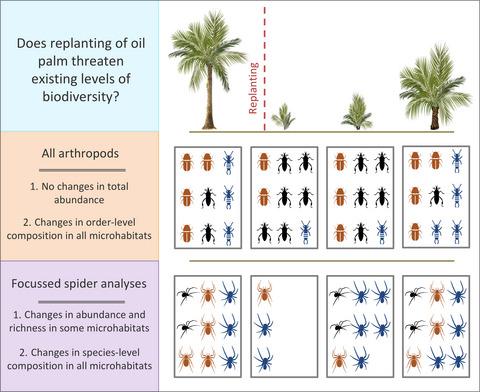当前位置:
X-MOL 学术
›
J. Appl. Ecol.
›
论文详情
Our official English website, www.x-mol.net, welcomes your feedback! (Note: you will need to create a separate account there.)
Assessing the effects of oil palm replanting on arthropod biodiversity
Journal of Applied Ecology ( IF 5.7 ) Pub Date : 2020-09-27 , DOI: 10.1111/1365-2664.13749 Michael D. Pashkevich 1 , Anak Agung Ketut Aryawan 2 , Sarah H. Luke 1 , Nadine Dupérré 3 , Helen S. Waters 1, 4 , Jean‐Pierre Caliman 2 , Mohammad Naim 2 , Edgar C. Turner 1
中文翻译:

评估油棕种植对节肢动物生物多样性的影响
更新日期:2020-09-27
Journal of Applied Ecology ( IF 5.7 ) Pub Date : 2020-09-27 , DOI: 10.1111/1365-2664.13749 Michael D. Pashkevich 1 , Anak Agung Ketut Aryawan 2 , Sarah H. Luke 1 , Nadine Dupérré 3 , Helen S. Waters 1, 4 , Jean‐Pierre Caliman 2 , Mohammad Naim 2 , Edgar C. Turner 1
Affiliation

|
- Palm oil is the most traded vegetable oil worldwide. Production is concentrated in Southeast Asia, where established oil palm plantations dominate the landscape in many regions. Although levels of biodiversity are much lower than in forest, mature oil palm plantations can support a wide range of generalist species. However, these species may be threatened, as large areas of plantation have already been, or will soon be, replanted as they near the end of their productive life (20–30 years). Replanting changes vegetation complexity and microclimate, but short‐ and long‐term effects on biodiversity are largely unstudied.
- We surveyed an oil palm chronosequence (first‐generation mature palms, and replanted second‐generation palms aged 1, 3 and 8 years) in an industrial plantation in Riau, Indonesia to assess the impacts of replanting over an 8‐year period on arthropods in the ground, understorey and canopy microhabitats. Replanting was carried out using current recommended strategies, which included staggering replanting events to promote landscape‐level heterogeneity, retaining mature oil palm riparian buffers, planting a cover crop immediately after replanting, and using chopped mature palms as mulch after clearance. We assessed changes in total arthropod abundance and order‐level community composition, as well as specific changes in spider communities.
- We observed no significant declines in total arthropod abundance after replanting, but arthropod order‐level community composition varied across the chronosequence in all microhabitats. These findings were replicated, or more pronounced, in spider‐specific analyses. Spider abundance and species richness decreased in the understorey in the first year after replanting (although these returned to pre‐replanting levels after 3 years), and spider species‐level community composition in all microhabitats differed significantly across the chronosequence.
- Synthesis and applications. Our findings indicate that total arthropod abundance is resilient to replanting of oil palm, but that replanting changes total arthropod and spider community composition and decreases spider abundance and species richness in some microhabitats. While it is somewhat encouraging from a management perspective that recommended replanting strategies maintain overall arthropod abundance, the changes in arthropod composition and spider biodiversity that we observed may impact ecosystem processes, such as pest control, in second‐generation oil palm plantations, with potential implications for yield. Additional studies that focus on other taxonomic groups and assess the effects of individual replanting strategies are needed before the long‐term ecological impacts of replanting on existing oil palm plantations can be fully determined.
中文翻译:

评估油棕种植对节肢动物生物多样性的影响
- 棕榈油是全球交易量最大的植物油。生产集中在东南亚,许多地区成熟的油棕种植园占主导地位。尽管生物多样性水平远低于森林,但成熟的油棕种植园可以支持多种通配物种。但是,这些物种可能会受到威胁,因为在接近生产寿命(20-30年)时,已经或即将种植大面积的人工林。补植改变了植被的复杂性和微气候,但对生物多样性的短期和长期影响尚待研究。
- 我们调查了印度尼西亚廖内一个工业种植园中的油棕的先后顺序(第一代成熟的棕榈,以及分别种植了1、3和8岁的第二代棕榈),以评估在8年的时间里再种植对节肢动物的影响。地面,下层和林冠微生境。使用当前推荐的策略进行补种,包括错开补植事件以促进景观水平的异质性,保留成熟的油棕河岸缓冲带,在补种后立即种植覆盖作物以及使用切碎的成熟棕榈作为清除后的覆盖物。我们评估了节肢动物总数和订单级群落组成的变化,以及蜘蛛群落的特定变化。
- 我们观察到,重新种植后,节肢动物总的丰度没有显着下降,但是在所有微生境中,节肢动物有序的群落组成在整个时间序列上都不同。这些发现在蜘蛛特异性分析中得以重复或更明显。重新种植后的第一年,地下层中蜘蛛的丰度和物种丰富度下降(尽管3年后恢复到重新种植前的水平),并且在整个时序上,所有微生境中蜘蛛物种水平的群落组成均存在显着差异。
- 综合与应用。我们的发现表明,节肢动物的总丰度对油棕的重新种植具有弹性,但重新种植会改变总节肢动物和蜘蛛的群落组成,并在某些微生境中降低蜘蛛的丰度和物种丰富度。尽管从管理的角度来看,建议的重新种植策略可以保持节肢动物的总体丰满度在某种程度上令人鼓舞,但我们观察到的节肢动物组成和蜘蛛生物多样性的变化可能会影响第二代油棕人工林中的生态系统进程,例如害虫控制,并可能产生影响。产量。在可以完全确定再种植对现有油棕种植园的长期生态影响之前,还需要进行其他针对其他分类学组别并评估个别再种植策略效果的研究。


























 京公网安备 11010802027423号
京公网安备 11010802027423号